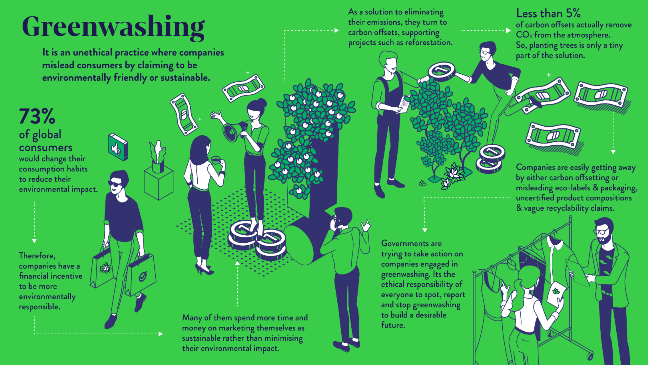Greenwashing – Hiding Truth Behind Green
Greenwashing refers to the practice of making misleading or false claims about the environmental benefits of a product, service, company, or practice in order to appear more environmentally friendly than they actually are. This term is often used in the context of marketing and advertising, where companies try to capitalize on the growing consumer demand for sustainable and eco-friendly products.
The term greenwashing was first coined in 1986 by environmentalist Jay Westerveld in an article where he decried the common practice of hotels asking guests to reuse towels to help conserve energy. Westerveld claimed that those same hotels did little to help the environment and that the towel request was an act of greenwashing.
Why Do Companies Engage in Greenwashing?
It’s simple – being seen as ethical drives profitability. A report by McKinsey found that Gen Z (people born roughly between 1996 and 2010) are more likely to spend money on companies and brands seen to be ethical. Another, Nielson’s Global Corporate Sustainability Report, found that 66% of consumers will spend more on a product if it comes from a sustainable brand, and that jumps to 73% among millennials. Therefore, companies have a financial incentive to be more socially conscious, or at least appear to.
Some greenwashing is unintentional, due to a lack of knowledge or understanding on the part of management, but sometimes greenwashing is also carried out intentionally through marketing efforts.Companies engaged in greenwashing might use vague or ambiguous terms, exaggerate the positive environmental impact of their products, or highlight a small eco-friendly aspect of their operations while downplaying or ignoring other negative environmental practices. The goal of greenwashing is to attract environmentally conscious consumers and improve the company’s reputation without making substantial changes to their actual environmental practices.
How Greenwashing is being done:
- Labelling a product as “natural” or “green” without any evidence to support these claims
- Advertising a product as “eco-friendly” while ignoring its significant negative environmental impacts
- Using images of nature or environmentally friendly symbols in advertising campaigns without substantiating the claims
- Highlighting a minor environmental improvement while diverting attention from larger environmental concerns
- Promoting a single positive aspect of a product while neglecting to mention its overall environmental footprint
Impacts of Greenwashing –Greenwashing can have several negative impacts on various stakeholders, including consumers, the environment, competitors, and the reputation of companies involved. Some of the key impacts of greenwashing include:
- Greenwashing misleads consumers into believing that they are making environmentally responsible choices when, in reality, they might be supporting companies with questionable or unsustainable practices.
- Companies that engage in greenwashing divert attention and resources away from truly sustainable practices.
- Greenwashing often involves misrepresenting a product’s or company’s environmental impact. This can result in consumers unknowingly supporting products or practices that contribute to pollution, resource depletion, and other environmental issues.
- Companies that rely on greenwashing may resist making meaningful improvements to their products or practices.
- Reputation Damage: Once greenwashing practices are exposed, companies risk damaging their reputation and credibility. This can result in public backlash, legal actions, and loss of customer loyalty.
- Regulators and government agencies may take action against companies that engage in deceptive marketing practices, leading to potential fines and legal consequences.
- Market Distortion: Greenwashing can create an uneven playing field in the market. Companies that genuinely invest in sustainable practices may struggle to compete with those that use deceptive marketing tactics to appear environmentally responsible.
Mitigation of Risks Associated with Green washing:Mitigating the risks associated with greenwashing involves adopting transparent, accountable, and genuinely sustainable practices. Some strategies to mitigate risks associated with greenwashing include:
- Commit to Genuine Sustainability
- Provide accurate and complete information about the environmental impacts of products, services, and practices
- Use clear and specific language in marketing materials and communications
- Establish clear sustainability goals and metrics to track progress over time.
- Develop and implement sustainable practices that reflect a genuine, long-term commitment to reducing environmental impacts
- Invest in Research and Development
- Engage Stakeholdersin sustainability initiatives
- Have a plan in place for handling potential greenwashing accusations
- Educate your marketing and communication teams about the importance of accurate environmental claims and the potential consequences of greenwashing.
Greenwashing can mislead consumers who want to make environmentally responsible choices by making it difficult to discern genuinely sustainable products from those that are only pretending to be. To counter greenwashing, consumers can look for third-party certifications from reputable organizations, do their own research on a company’s environmental practices, and critically evaluate claims made in advertising materials. The term “greenwashing” serves as a reminder that businesses should be held accountable for their environmental practices and that genuine efforts toward sustainability require more than just superficial marketing tactics. It emphasizes the importance of responsible and ethical behaviour in addressing environmental concerns.


